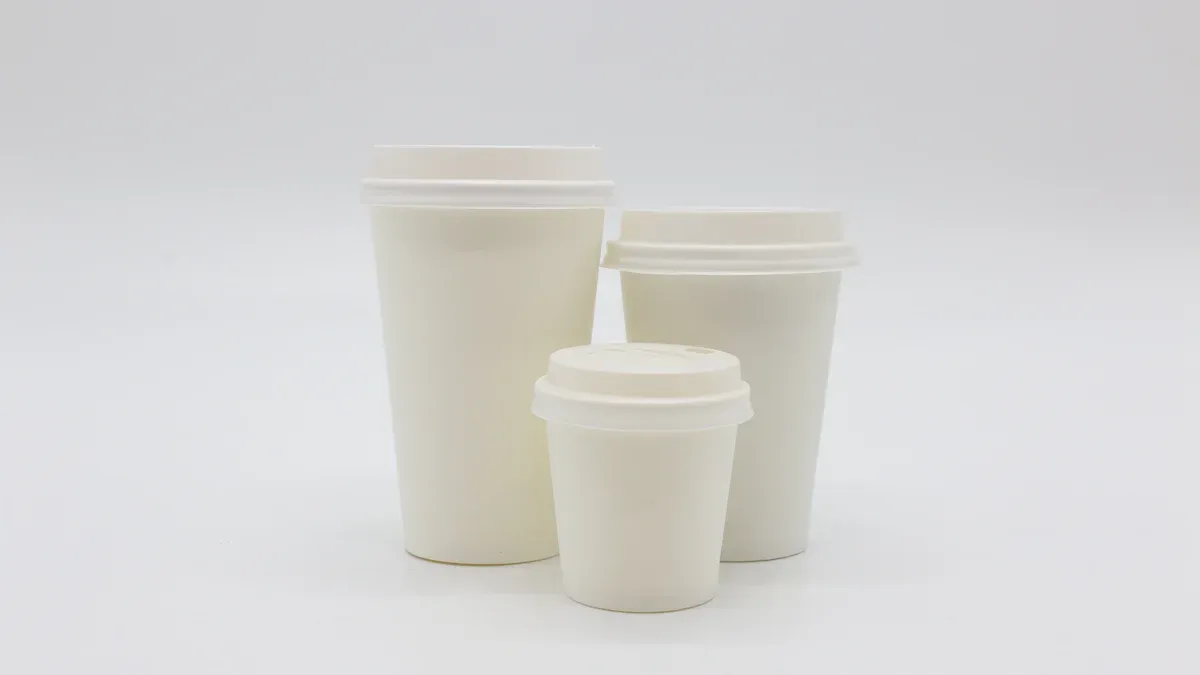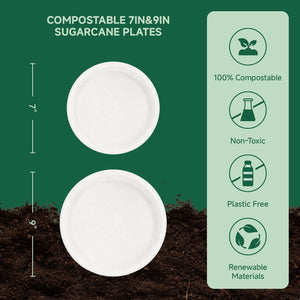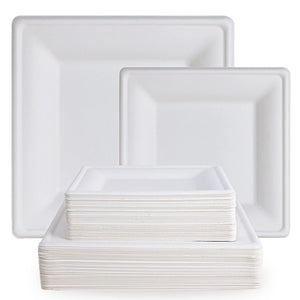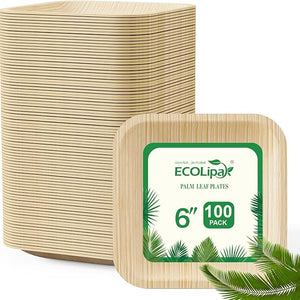Choosing the right eco-friendly plate can feel confusing. For most parties and single-use needs, sugarcane plates are the better option. This choice supports sustainability in a big way. The material comes from a repurposed waste product of sugar production. The market for eco-friendly disposable plates is growing fast, expected to reach nearly $10.0 billion by 2033 as more people seek sustainable choices.
Key Takeaway: Sugarcane is a top eco-friendly choice. Bamboo is a durable material, making bamboo plates a strong pick for very heavy-duty uses.
This guide breaks down the details of these eco-friendly materials. It helps you pick the best compostable plates and cutlery confidently.
Key Takeaways
Sugarcane plates are a top eco-friendly choice for most events. They use waste material from sugar production.
Sugarcane plates break down quickly in compost. They are good for both home and industrial composting.
Sugarcane plates are strong and handle hot foods well. They are also more affordable than bamboo plates.
Bamboo plates are very rigid. They are best for very heavy meals, but they cost more and take longer to compost.
Choose sugarcane plates for a good balance of strength, cost, and easy composting. This helps the planet.
KEY DIFFERENCES BETWEEN BAMBOO AND SUGARCANE

Understanding the key differences between bamboo and sugarcane helps you see the full environmental picture. Both materials offer an escape from plastic, but their journeys from nature to your table are very different. Examining their pros and cons reveals why one is often a better choice for single-use plates. The story of these eco-friendly materials begins with their source.
SOURCE MATERIAL: WASTE VS. CROP
The biggest distinction lies in what the pulp is made from. This single fact has a huge impact on sustainability.
Sugarcane Pulp (Bagasse): A True Waste Product Sugarcane plates come from a material called bagasse. This is the dry, fibrous pulp left over after juice is squeezed from sugarcane stalks to make sugar. Each year, the world produces hundreds of millions of metric tons of this material, which would otherwise be burned or thrown away. Using sugarcane pulp turns this massive waste stream into valuable, sustainable products. This process of upcycling is a major win for the environment.
Bamboo Pulp: A Dedicated Crop Bamboo, on the other hand, is a dedicated crop. While it is a highly sustainable resource because it grows incredibly fast, it is harvested specifically to make products. The bamboo pulp used for plates is just one of its many applications. People use bamboo for everything from construction scaffolding and flooring to clothing and musical instruments. This means making bamboo pulp requires harvesting a crop that has other important uses.
RESOURCE USE: WATER AND LAND
The growth and sustainability of each plant also show important differences. Both have benefits, but they come with trade-offs.
Did You Know? Sugarcane is a C4 plant. This means it is exceptionally good at capturing carbon dioxide from the atmosphere and converting it into biomass, making it a powerful tool in fighting climate change.
Bamboo is famous for its low-impact growth. It requires very little water and typically grows without any pesticides or fertilizers. However, the rise of large, industrial bamboo plantations has raised concerns. These single-crop farms can reduce biodiversity. In some cases, they have been linked to a loss of wildlife and an increased risk of landslides.
Sugarcane is a more traditional agricultural crop. Commercial farming uses standard resources like water and fertilizers to ensure a healthy harvest. This managed approach supports a massive global food industry. The sugarcane pulp for plates is a byproduct of that existing system, not the reason for it.
THE TRUTH ABOUT SUSTAINABILITY
The final chapter in a plate's life is its disposal. Here, the biodegradability and compostability of sugarcane and bamboo set them apart. This is where the better option for everyday convenience becomes clear.
For a product to be truly compostable, it must meet specific international standards like ASTM D6400 or EN 13432. These certifications ensure a material breaks down safely and completely within a set timeframe in a commercial facility.
Feature |
Sugarcane (Bagasse) Plates |
Bamboo Plates |
|---|---|---|
Compost Time |
Fast: Typically 45-90 days. |
Slower: Often 3-6 months. |
Compost Type |
Home & Industrial |
Industrial Facility Required |
End-of-Life |
Breaks down easily into soil. |
Needs specific conditions to decompose. |
Sugarcane pulp shines in this area. It is a biodegradable material that decomposes quickly. Most sugarcane plates can break down in a home compost bin in just a few months. In an industrial facility, they can be gone in as little as 45 to 90 days.
Bamboo pulp takes longer. Because it is a woodier material, it generally needs the high heat of an industrial composting facility to decompose, a process that can take up to 180 days. This makes it less practical for people who want to compost at home. For those seeking convenient and truly eco-friendly compostable plates and cutlery, the rapid biodegradability and compostability of sugarcane makes it a superior choice. This is a key part of the key differences between bamboo and sugarcane when choosing sustainable food packaging.
PERFORMANCE, COST, AND YOUR CHOICE
Choosing between eco-friendly materials goes beyond their origin story. Performance and price are huge factors in your decision. How a plate holds up to a saucy meal or fits into your party budget matters. This section compares sugarcane and bamboo on these practical points. It will help you find the best option for your needs.
STRENGTH AND DURABILITY
A disposable plate’s main job is to hold your food without bending or breaking. Both sugarcane and bamboo offer strong alternatives to flimsy paper plates. However, their texture and reliability can differ.
Bamboo plates are known for their rigidity. The woody fibers of bamboo create a very stiff material. This makes them a solid choice for the heaviest meals.
Modern sugarcane plates, however, are engineered for impressive strength. High-quality options, like the compostable plates from Ecolipak, are made by pressing sugarcane pulp under high heat and pressure. This process creates a remarkably sturdy and reliable plate. Many users find them more than strong enough for any party food, from loaded burgers to hefty slices of cake. Customer feedback often highlights how these sugarcane plates handle various foods without any issues. They are also microwave and freezer safe, adding a layer of convenience that makes them a top performer in the world of eco-friendly disposable tableware.
HANDLING HOT AND WET FOODS
The real test for any disposable plate is how it handles heat, liquids, and oils. No one wants a soggy plate that leaks onto their lap. This is an area where the natural properties of sugarcane pulp and bamboo pulp show clear differences.
Bamboo pulp is naturally resistant to water and oil. This is a key advantage of the material. However, some sugarcane plates require a little help to achieve the same level of performance.
Attribute |
Bamboo Pulp |
Sugarcane Pulp |
|---|---|---|
Water/Oil Resistance |
Naturally resistant |
Requires treatment for best results |
To improve resistance, some manufacturers treat their bagasse products with man-made chemicals called PFAS. These chemicals create a barrier against grease and water. While effective, PFAS are known as "forever chemicals" because they do not break down in the environment and can pose health risks. This treatment compromises the compostability and safety of the product. Thankfully, many high-quality sugarcane plates are now made without these harmful additives. It is important to choose products that are certified compostable and explicitly state they are PFAS-free.
When it comes to heat, high-quality sugarcane plates perform exceptionally well. They are a great choice for serving hot meals right from the grill or reheating leftovers.
Ecolipak's bagasse plates can handle temperatures up to 220 degrees Fahrenheit, ensuring they remain sturdy and safe for hot foods.
This makes sugarcane a versatile and safe option for all kinds of meals, giving you peace of mind at your events.
THE BUDGET-FRIENDLY ECO-FRIENDLY OPTION
Making a sustainable choice should not have to break the bank. Cost is a major factor for families, event planners, and businesses. When comparing prices, sugarcane almost always comes out ahead.
The reason is simple. Manufacturing pulp from bagasse (sugarcane) uses less energy than making pulp from harvested bamboo. The raw material for sugarcane plates is an agricultural waste product. This makes the sugarcane pulp less expensive to source and process. This cost-saving is passed on to you, making eco-friendly disposable dinnerware more accessible.
Bamboo products, on the other hand, tend to be more expensive. The costs of sustainable farming, harvesting a dedicated crop, and processing the woody pulp all contribute to a higher price tag. For those looking for an affordable and truly eco-friendly option for parties and daily use, sugarcane plates offer the perfect blend of sustainability and value. You can get excellent compostable plates and cutlery, like sugarcane fiber cutlery, without stretching your budget. This makes it easier for everyone to make a green choice.
MAKING THE RIGHT DECISION FOR YOUR EVENT
Now you know the facts about sugarcane and bamboo. Making the right choice for your event is simple. It comes down to your specific needs for performance, disposal, and budget. This guide helps you select the perfect eco-friendly materials for any occasion.
WHY CHOOSE ECOLIPAK SUGARCANE PLATES
For most events, Ecolipak's sugarcane plates are the ideal solution. These plates are made from sugarcane pulp, a reclaimed resource. They offer impressive strength for all types of food. Their design ensures they are sturdy and reliable, giving you confidence when serving guests. Choosing these sustainable products means you get high performance without harming the planet. The sugarcane pulp material is fully compostable, breaking down quickly after use. This makes cleanup easy and truly eco-friendly.
WHEN BAMBOO MIGHT BE BETTER
Bamboo plates have a place in specific situations. The woody bamboo pulp creates an extremely rigid plate. If you need maximum stiffness for the heaviest, most demanding meals, bamboo can be a good choice. Some thicker bamboo plates can even be gently washed and reused for a short time. However, for single-use convenience and fast compostability, sugarcane pulp remains the better option for the majority of needs. The bamboo pulp requires more specific conditions to break down.
CHOOSING YOUR ECO-FRIENDLY DISPOSABLE DINNERWARE
Think about your event. Is it a backyard barbecue, a formal wedding, or a quick family picnic?
For large gatherings where convenience and quick cleanup are key, sugarcane is the winner.
For a smaller event where you need extreme rigidity, bamboo might be considered.
Your choice of eco-friendly disposable dinnerware reflects your commitment to a healthier planet. The sugarcane pulp used in quality plates provides a fantastic balance of strength and sustainability.
BEYOND PLATES: COMPOSTABLE PLATES AND CUTLERY
A complete sustainable meal setting needs more than just plates. You also need forks, knives, and spoons. Sugarcane fiber cutlery is a perfect match for sugarcane plates. It is lightweight, strong, and composts easily.
Another material you might see is CPLA, a type of compostable plastic made from corn starch. While it comes from renewable plants, CPLA has a major drawback. It needs an industrial composting facility to break down. It will not decompose in a home compost pile.
Home Composting: A Clear Difference A 2022 study showed how slowly some materials break down at home. Cutlery made from natural fibers is a much better choice for home composters.
Cutlery Type |
Decomposition Time in Home Compost |
|---|---|
Wooden/Sugarcane Fiber |
Approximately 3 months |
CPLA |
Up to 80 years |
This shows that for true end-of-life convenience, choosing compostable plates and cutlery made from natural pulp like sugarcane or wood is the most effective and sustainable path.
For most events, parties, and businesses, sugarcane plates are the clear winner. They offer true sustainability through waste reduction, fast compostability, and lower costs. Ecolipak provides a durable, high-quality version of this top choice, using strong sugarcane pulp. While bamboo pulp offers maximum rigidity, the sugarcane pulp from sugarcane is the better sustainable option. This pulp is ideal for compostable plates and cutlery. The sugarcane pulp pulp from sugarcane is a better choice than bamboo bamboo bamboo bamboo pulp.
Ready to make the green choice? 🌎 Green Pack, Go for ECOLIPAK.
FAQ
Are sugarcane plates really strong?
Yes, they are very strong. High-quality sugarcane plates, like those from Ecolipak, are pressed to be sturdy and reliable. They easily hold heavy foods without bending or leaking. Users find them great for parties, picnics, and everyday meals.
Is it safe to microwave sugarcane plates?
Absolutely. Sugarcane plates are safe for both the microwave and the freezer. They handle hot foods well without releasing harmful chemicals. This makes them a convenient and healthy choice for reheating leftovers or serving warm dishes at any event.
How do I compost sugarcane plates at home?
Composting sugarcane plates is simple. Just break the plate into smaller pieces and add it to your home compost bin. The material breaks down naturally into nutrient-rich soil in just a few months, helping your garden grow.
Are eco-friendly plates expensive?
Sugarcane plates are a budget-friendly eco-option. They use a reclaimed waste material, which lowers production costs. This makes sustainable choices like Ecolipak plates affordable for families, businesses, and anyone planning an event on a budget.









